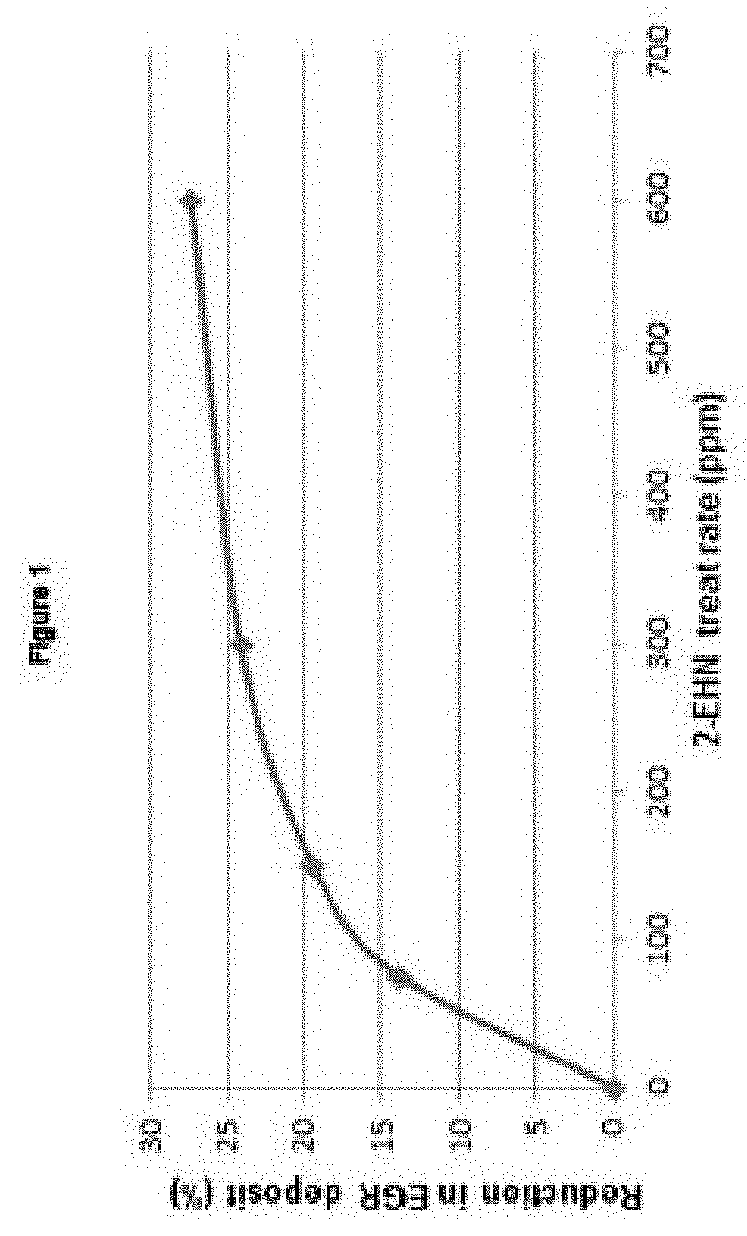Use and method to reduce deposits in compression ignition internal combustion engines
- Summary
- Abstract
- Description
- Claims
- Application Information
AI Technical Summary
Benefits of technology
Problems solved by technology
Method used
Image
Examples
example 1
[0109]A sequence of engine tests was carried out according to Method A as shown above. All runs were carried out without EGR deposit reducing additive, with the exception of Example 1b where the B7 base fuel was treated with 2-ethylhexyl nitrate (2-EHN) (600 ppm). The results are shown in Table 1:
TABLE 1Dry Deposit Mass (g)TreatIntakeEGRTotal DryRatePlasticOutletEGREGREGRDepositE.g.Additive(ppm)PipePipeValveCoolerHousingMass (g)1a*—00.451.480.059.472.9614.411b2-EHN6000.610.760.076.57210.011c*—00.61.290.169.012.6413.7*Comparative ExampleFrom Examples 1a and 1c, the average Total Dry Deposit Mass in the absence of 2-EHN was calculated as 14.06 g.The % reduction in EGR deposit due to the application of 2-EHN (600 ppm) under the Method A test condition was calculated as 28.8%.
example 2
[0110]A sequence of engine tests was carried out according to Method B as shown above. In example 2a, the B7 base fuel (which also comprised a commercial detergent package) was treated with 2-EHN (600 ppm). The results of Example 2 are shown in Table 2 below.
TABLE 2Dry Deposit Mass (g)TreatIntakeEGRTotal DryRatePlasticOutletEGREGREGRDepositE.g.Additive(ppm)PipePipeValveCoolerHousingMass (g)2a2-EHN6001.081.020.117.712.2612.182b*—01.192.370.269.73.2416.76*Comparative ExampleThe % reduction in EGR deposit due to the application of 2-EHN (600 ppm) under the Method B test condition was calculated as 27.3%.
example 3
[0111]A sequence of engine tests was carried out according to Method B as shown above. In example 3b, the B7 base fuel (which also comprised a commercial additive package) was treated with 2-EHN (300 ppm). The results of Example 3 are shown in Table 3 below.
TABLE 3Dry Deposit Mass (g)TreatIntakeEGRTotal DryRatePlasticOutletEGREGREGRDepositE.g.Additive(ppm)PipePipeValveCoolerHousingMass (g)3a2-EHN3000.821.270.098.452.4413.073b*—01.22.950.149.543.417.23*Comparative ExampleThe % reduction in EGR deposit due to the application of 2-EHN (300 ppm) under the Method B test condition was calculated as 24.1%.
PUM
 Login to View More
Login to View More Abstract
Description
Claims
Application Information
 Login to View More
Login to View More - R&D
- Intellectual Property
- Life Sciences
- Materials
- Tech Scout
- Unparalleled Data Quality
- Higher Quality Content
- 60% Fewer Hallucinations
Browse by: Latest US Patents, China's latest patents, Technical Efficacy Thesaurus, Application Domain, Technology Topic, Popular Technical Reports.
© 2025 PatSnap. All rights reserved.Legal|Privacy policy|Modern Slavery Act Transparency Statement|Sitemap|About US| Contact US: help@patsnap.com

